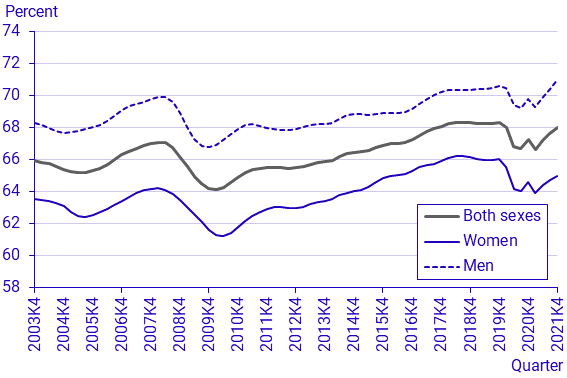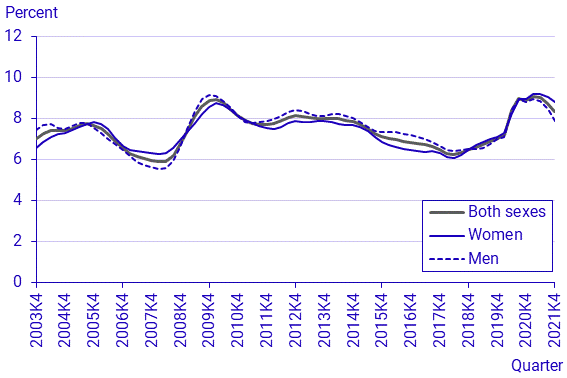Labour Force Surveys (LFS), 4th quarter 2021
Unemployment decreases among both people born in Sweden and foreign born people
Statistical news from Statistics Sweden 2022-02-08 8.00
In the fourth quarter of 2021 there were 5 084 000 employed persons aged 15–74 years, not seasonally adjusted. There were 410 000 unemployed persons, which corresponds to an unemployment rate of 7.5 percent. The average weekly hours worked was 157.8 million hours. Seasonally adjusted and smoothed data shows that employment increased compared with the third quarter 2021, and that there were 5 106 000 persons employed in total. The unemployment rate was 8.3 percent, a decrease compared with the third quarter 2021.
Since 1 January 2021, the Swedish LFS is in compliance with the new EU framework regulation on social statistics (Regulation (EU) 2019/1700 of the European Parliament and of the Council). This framework regulation has involved changes in the definition of employment, the sampling procedure, and the structure of the questionnaire. These changes have caused breaks in the time series and therefore, this item of statistical news does not include any comparisons with previous years. Comparisons within 2021 are possible for seasonally adjusted and smoothed data. However, comparisons with previous years are not advised. Throughout 2021, parallel measurements have been used to make it possible to link data backwards in time and make the series comparable with previous years.
The number of employed persons has been affected, partly due to the change in the definition; people who are completely absent from work for three months or more for certain reasons are no longer classified as being employed. Furthermore, new and updated information is used in the weighting procedures, which improves the precision in the estimates, although it also affects the levels of the number of employed persons. The change in the definition and the new weighting procedure led to a total estimated number of employed persons in the fourth quarter that is approximately 66 000 fewer than according to the previous method.
Besides the number of employed persons, other estimates may also have been affected by a change in definition, target population, and survey design. The new auxillary information may also have affected the other estimates.
More information on the alignment to the framework regulation is available on the LFS product page at “Information on the introduction of the new 2021 framework regulation in the LFS” (scb.se).
The labour force
There were 5 494 000 people aged 15–74 years in the labour force in the fourth quarter of 2021, not seasonally adjusted. There were 2 593 000 women and 2 901 000 men in the labour force. The relative labour force participation rate was 73.1 percent. For women it was 70.2 percent, and for men it was 76.0 percent. There were 569 000 young people aged 15–24 years in the labour force and the relative labour force participation rate among young people was 49.5 percent.
Seasonally adjusted and smoothed data shows that there were 5 568 000 people in the labour force in the fourth quarter, which corresponds to 74.2 percent of the population.
Employment
In the fourth quarter of 2021, there were 5 084 000 people aged 15–74 years in employment, not seasonally adjusted. There were 2 385 000 women and 2 699 000 men in employment. The employment rate was 67.7 percent. It was 64.6 percent for women and 70.7 percent for men. There were 450 000 young people aged 15–24 years in employment and the employment rate was 39.2 percent.
Seasonally adjusted and smoothed data shows that there were 5 106 000 employed persons and the employment rate was 68.0 percent. Compared with the third quarter, the number of employed people, as well as the employment rate, increased.
Employees
In the fourth quarter of 2021, there were 4 567 000 employees, not seasonally adjusted. Among employees, 2 246 000 were women, and 2 320 000 were men. There were 3 907 000 permanent employees, of whom 1 877 000 were women and 2 030 000 were men. The number of temporary employees was 660 000. Among temporary employees, 369 000 were women and 291 000 were men.
Seasonally adjusted and smoothed data shows that there were 4 590 000 employees, an increase compared with the third quarter. The number of permanent employees increased to 3 901 000 and the number of temporary employees decreased to 689 000.
Hours worked
The total number of hours worked averaged 157.8 million per week, according to non-seasonally adjusted data for the fourth quarter of 2021.
Seasonally adjusted and smoothed data shows that the total number of hours worked averaged 152.4 million hours per week.
The majority of employed persons have an agreed working time of 35 hours or more per week, that is, full-time work. In the fourth quarter of 2021, 4 003 000 people worked full time, of whom 1 732 000 were women and 2 270 000 were men. In total, 300 000 people worked short part-time (1–19 hours) and 611 000 people worked long part-time (20–34 hours).
The average actual weekly hours worked among employed persons aged 15-74 years was 31.0 hours in the fourth quarter of 2021. The average weekly hours worked was 28.9 hours among women and 33.0 hours among men.
Underemployment
Among employed persons aged 15–74 years, 292 000 were underemployed in the fourth quarter of 2021. Among underemployed persons, 145 000 were women and 147 000 were men. Underemployed persons accounted for 5.7 percent of employed persons.
Unemployment
In the fourth quarter of 2021, there were 410 000 unemployed persons aged 15–74 years, not seasonally adjusted. This corresponds to an unemployment rate of 7.5 percent. There were 208 000 unemployed women and 202 000 unemployed men. The unemployment rate was 8.0 percent for women and 7.0 percent for men.
Among people aged 15–74 years, seasonally adjusted and smoothed data shows that there were 463 000 unemployed persons, which corresponds to an unemployment rate of 8.3 percent in the fourth quarter of 2021. Compared with the third quarter, the number of unemployed people as well as the unemployment rate decreased.
There were 156 000 long-term unemployed persons (unemployed for at least 27 weeks) aged 15–74 years in the fourth quarter of 2021. Among long-term unemployed persons, 78 000 were women and 77 000 were men.
There were 118 000 unemployed young people aged 15–24 years, not seasonally adjusted. This corresponds to a youth unemployment rate of 20.8 percent. Among unemployed youth, 77 000 were full-time students.
Among young people aged 15–24 years, seasonally adjusted and smoothed data shows a decrease in the number of unemployed persons as well as in the unemployment rate compared with the third quarter. The number of unemployed young people was 150 000 and the youth unemployment rate was 24.2 percent.
Not in the labour force
The group ‘not in the labour force’ includes people who are classified as neither employed nor unemployed. In the fourth quarter of 2021, there were 2 018 000 people aged 15–74 years not in the labour force, of whom 1 102 000 were women and 916 000 were men. Among people not in the labour force, 871 000 were pensioners, while 685 000 were full-time students. There were 292 000 people who reported that they were on long-term sick leave.
Latent job seekers
There were 277 000 latent job seekers aged 15–74 years in the fourth quarter of 2021, of whom 137 000 were women and 139 000 were men. There were 139 000 latent job seekers among young people aged 15–24 years.
Unused labour supply
Unemployed persons, underemployed persons and latent job seekers together comprise the unused labour supply. In the fourth quarter of 2021, among people in the aged 15–74 years, the unused labour supply averaged 20.7 million hours per week. The unused labour supply corresponds to 518 000 full-time employments with a 40-hour working week.
Labour market for people aged 20-64 years
The relative labour force participation rate among people aged 20–64 years was 86.9 percent in the fourth quarter of 2021, not seasonally adjusted. For women, the relative labour force participation rate was 83.8 percent and for men it was 89.9 percent. Seasonally adjusted and smoothed data shows that the labour force participation rate was 87.8 percent.
In the fourth quarter of 2021, the proportion of employed people aged 20–64 years was 81.2 percent, not seasonally adjusted. For women, this figure was 78.1 percent, and for men it was 84.2 percent. Seasonally adjusted and smoothed data shows that the employment rate was 81.5 percent, an increase compared with the third quarter of 2021.
According to non-seasonally adjusted data, the unemployment rate in the age group 20–64 years was 6.6 percent. The unemployment rate was 6.8 percent for women and 6.3 percent for men. According to seasonally adjusted and smoothed data, the unemployment rate was 7.2 percent, a decrease compared with the third quarter of 2021.
Swedish born and foreign born persons aged 20–64 years
In the fourth quarter of 2021, the relative labour force participation rate among Swedish born persons aged 20–64 years was 88.1 percent, not seasonally adjusted. Among Swedish born women, the corresponding figure was 85.8 percent and among Swedish born men it was 90.2 percent. Among foreign born persons aged 20–64 years, the relative labour force participation rate was 83.7 percent in the fourth quarter of 2021. The labour force participation rate was 78.4 percent among foreign born women and 89.0 percent among foreign born men. According to seasonally adjusted and smoothed data, the labour force participation rate increased compared with the third quarter among foreign born persons. Among Swedish born persons, the labour force participation rate was 88.9 percent, and among foreign born persons it was 84.6 percent.
In the fourth quarter of 2021, the proportion of employed persons among Swedish born persons aged 20–64 years was 85.1 percent, not seasonally adjusted. The employment rate was 83.2 percent among Swedish born women and 86.9 percent among Swedish born men. Among foreign born persons the employment rate was 70.2 percent. Among foreign born women the corresponding figure was 63.9 percent, while among foreign born men it was 76.4 percent. Seasonally adjusted and smoothed data shows that the employment rate increased among both Swedish born and foreign born persons compared with the third quarter of 2021. The employment rate was 85.4 percent among Swedish born persons, and 70.1 percent among foreign born persons.
The relative unemployment rate among Swedish born persons aged 20–64 years was 3.4 percent in the fourth quarter of 2021. The unemployment rate was 3.0 percent among Swedish born women and 3.7 percent among Swedish born men. The unemployment rate among foreign born persons was 16.2 percent. Among foreign born women, the unemployment rate was 18.4 percent, and among foreign born men the corresponding figure was 14.2 percent. According to seasonally adjusted and smoothed data, the unemployment rate decreased among both Swedish born and foreign born persons. The unemployment rate was 3.9 percent among Swedish born persons and among foreign born persons it was 17.2 percent.


Definitions and explanations
Since the LFS is a sample survey, the results are subject to some uncertainty. The LFS basic tables contain uncertainty figures and refer to non-seasonally adjusted data.
Seasonally adjusted and smoothed data (trend values): data in which normal seasonal variations have been removed, then smoothed to reduce sampling error and short-term variations. Seasonally adjusted and smoothed data may be revised following new monthly outcomes and usually does not coincide with non-seasonally adjusted data. Seasonally adjusted and smoothed data is not to be compared with non-seasonally adjusted data.
More detailed results are available in the form of figures and tables on employed persons, hours worked, unemployed persons and more, on Statistics Sweden’s website.
Feel free to use the facts from this statistical news but remember to state Source: Statistics Sweden.
